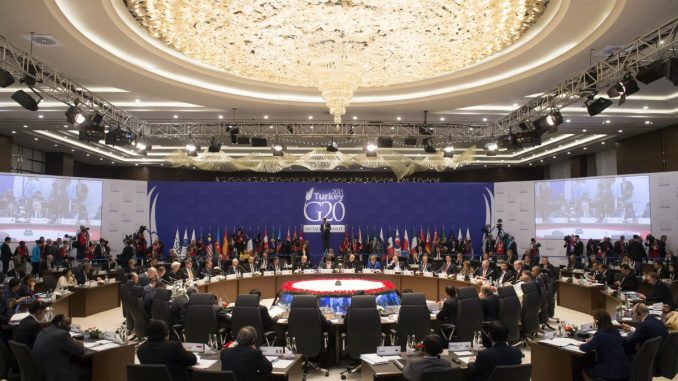
Commentary
In the past year, various potential risks of economic globalization have gradually surfaced. A series of events raised the alarm, including the COVID-19 pandemic, the U.S.-China cold war, the global chip shortage crisis, skyrocketing shipping costs caused by a global shortage of containers, and the unexpected blockage of the Suez Canal.
Economic globalization has always been viewed as an inevitable trend. However, few multinational companies and economic experts have thought carefully about the prerequisite to the various benefits of economic globalization—world peace. When something as serious as the U.S.-China cold war occurs, which impacts half of the world, huge problems stemming from globalization will soon arise.
In addition, the benefits of economic globalization can only be realized as long as no major incidents occur on a global scale; otherwise, economic globalization will plunge into chaos. This is an important issue that many multinational companies and economic experts ignored.
From the 1990s until the beginning of last year, Asia, Europe, North America, and South America generally enjoyed a peaceful environment and there were no major incidents. Consequently, many people in business circles almost forgot the potential risks associated with economic globalization.
However, in 2020, the Chinese regime launched three military operations to intimidate the United States: it sent a naval fleet to a U.S. military base on Midway Island, announced its intention to occupy the international waters of the South China Sea to establish its naval base, and developed a navigation system to enable precise intercontinental missile attacks on the entire United States. These military provocations ignited the U.S.-China cold war, and the peaceful environment that economic globalization had relied on for the past 30 years became increasingly fragile.
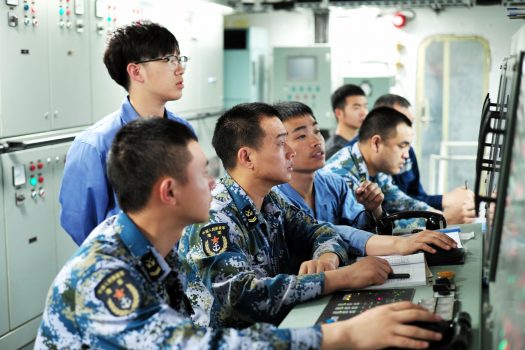
Although many Western media refuse to accept this reality, and U.S. President Joe Biden refuses to admit that the Chinese regime is now a strategic enemy of the United States, the reality of the U.S.-China cold war has forced the U.S. military to make comprehensive war preparations. The Chinese regime has continued to flex its military muscle. The risk of war between the United States and China is certainly real.
The U.S.-China cold war is not accidental—in the eyes of the Chinese Communist Party (CCP) it is inevitable. The CCP has always harbored the ambition to be a superpower, and kept these final goals in mind: disrupting international law and order, being a threat to the United States, and dominating the world.
After years of military expansion and war preparations, the new cold war was finally triggered as planned. The media and experts from around the world failed to see the inevitability of the U.S.-China cold war because they were either blinded or too biased to discern the truth.
In such an international atmosphere, economic globalization was hit by a series of unexpected events that started last year and multinational companies were totally unprepared. These events—such as the partial paralysis of the global economy due to the pandemic, the chaos of the global container shortage, the global chip crisis, and the recent Suez Canal blocking the Asia-Europe transportation artery—highlight the embarrassing situation in economic globalization: passive responses to unexpected events.
The ‘Butterfly Effect’ and the Global Chip Crisis
Among the aforementioned unexpected events, the crisis caused by the global shortage of computer chips is a typical case of the “butterfly effect.”
The butterfly effect means that in a dynamic system, small changes that occur in one area can produce a long-term and significant chain reaction in the entire system. The idea of the butterfly effect is used in Chaos theory. It was Edward Lorenz, an American meteorologist, who identified this effect. When describing the phenomenon, he used a metaphor and posed the question, “Does the flap of a butterfly’s wings in Brazil set off a tornado in Texas?”
The microchip supply chain is a typical product of economic globalization. To process countless grains of sand into chips, more than 2,000 complicated procedures are needed. No country can complete all these steps on its own. According to the latest analysis by the American Semiconductor Industry Association, in terms of intellectual property rights and software for designing cutting-edge chips, the United States is the world leader. The key special gases for manufacturing chips come from Europe, some necessary chemicals are produced in Japan, and the most advanced chip manufacturers are all located in Asia, with 92 percent in Taiwan.
In the past year, a series of unrelated major incidents occurred in the chip industry. Each event was either a regional incident, a decision-making error, or chaos caused by hasty responses. But, added together, they created a domino effect in the chip manufacturing chain, leading to the crisis of a global chip shortage.
First, after the COVID-19 pandemic broke out last spring, the auto manufacturers in various countries significantly reduced production and thus canceled a large number of orders for automotive chips to save costs.
Then, after the CCP started the U.S.-China cold war, the United States imposed sanctions on China’s high-tech companies. These companies rushed to buy a large number of chips before the sanctions took effect, which exhausted the production capacity of chip companies. When auto manufacturers later resumed production and placed orders for chips, the chip companies were unable to meet demand for a period of time.
At the end of last year, the industry was seeing a massive shortage of Ajinomoto build-up film (ABF), a small yet critical substrate used by chip companies. Ajinomoto is actually a food and seasoning company, and ABF is produced as a byproduct during the making of the food additive MSG (monosodium glutamate). It was said that Chinese restaurants in various countries had reduced their MSG orders due to reduced business caused by the pandemic, which led to a reduction in ABF production and eventually affected chip production companies around the world.
On Feb. 4, a fire broke out at a Unimicron plant in Taoyuan city, Taiwan, which caused additional disruption to parts supply. Unimicron is a PCB (printed circuit board) and IC (integrated circuit) manufacturer.
Japan’s Renesas Electronics Corporation, the third largest auto chip supplier in the world, experienced a power outage at its Naka factory, caused by a magnitude 7.3 earthquake on Feb. 13, that temporarily halted operations.

A winter storm that hit Texas in mid-February caused a large-scale power outage. Several auto chip factories in the affected region were forced to suspend production.
Additionally, on March 19, a factory of Japan’s Renesas Electronics caught fire and stopped production.
Among the events listed above, only one was related to a business decision—the reduction of orders by various automakers. One event was the result of a government decision. Of the remaining five factors, two were natural disasters—the Japanese earthquake and the winter storm that hit Texas, two were fires in Japanese and Taiwanese companies, and one was a misfortune that came out of nowhere.
These factors were not related to one another and occurred in different countries; but together resulted in the chip crisis. Although automotive chips account for less than 10 percent of the semiconductor market, with an annual market of about $40 billion, the chip crisis they incurred has already impacted the economies of almost every country involved.
Now, the chip crisis has further spread, from a shortage of auto chips that led to the suspension of automobile production in many countries, to the shortage of mobile phone chips, which led to the reduction of mobile phone production. Furthermore, chip shortages and price increases triggered the soaring prices of various Chinese-made household appliances. The semiconductor industry chain and chip users in various fields are now facing an unprecedentedly difficult situation.
Container Shortages Cause Global Price Rise
Everyone knows that the pandemic has caused an economic halt in almost every country in the world. However, companies didn’t anticipate that the pandemic would cause a global logistics disruption and shortage of containers, nor did they take preventive measures.
Since the outbreak of the pandemic, global cargo transportation has dropped sharply due to lockdown measures. Shipping companies in different countries have suspended routes and dismantled a large number of idle container ships. Eleven of the world’s 12 largest container shipping companies have cut shipping volumes and reduced their fleets. There are also many small- and medium-sized shipping companies closing down due to financial losses from the long-term freeze.
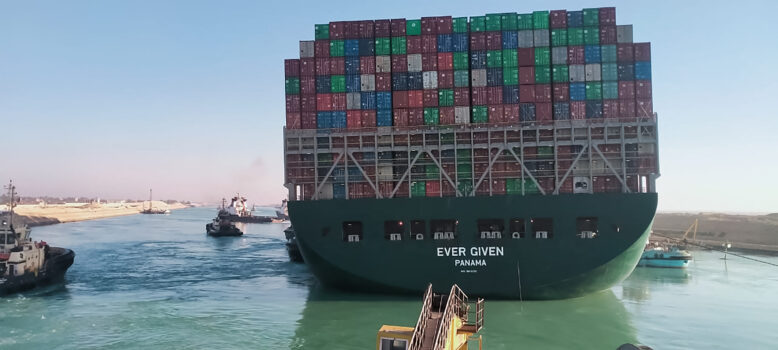
During the pandemic, ports all over the world couldn’t operate normally. The transportation and route suspensions resulted in a large accumulation of containers in China’s ports. After the pandemic eased in China, a large number of containers were shipped to Europe and the United States, but these countries couldn’t fill the containers and return them to Asia as they were still fighting the pandemic. Therefore, a large number of empty containers were backlogged around the globe, causing a shortage of containers in China and partial interruption of the global flow.
During the peak sales season in the United States in November 2020, China was faced with a severe container shortage, and shipping costs rose sharply. In early March last year, the freight cost for each container shipped from China to the United States was $1,361. By September, the rates from Shanghai to the East and West coasts of the United States were $4,622 and $3,848, respectively, an increase of almost two and a half times the usual rate.
An even bigger problem is maritime transportation safety. In order to meet the needs of customers, the shipping companies tried their best to sail with full loads, resulting in extremely high container piles. According to a Bloomberg report, Reed Marine Maritime Casualty Management Consultancy pointed out that due to the likelihood of extreme weather and turbulent waves in the North Pacific in winter, it would be best for large container ships to slow down to overcome the turbulence and mitigate the dangers from bad weather. However, driven by demanding customers who paid skyrocketing freight rates, the ships were sailing at fast speeds despite the dangers. As a result, accidents occurred frequently.
According to a report from The Wall Street Journal, on Nov. 30, 2020, a container ship sailing from Yantian Port in Shenzhen to Long Beach, California encountered a severe storm about 1,600 nautical miles northwest of Hawaii. Approximately 1,816 containers on the ship fell into the ocean.
On Dec. 12 last year, a boxship managed by Taiwan’s Evergreen Marine Corp. lost around 40 containers off the coast of Japan while crossing the Pacific.
On Jan. 16, a container ship from Xiamen going to Los Angeles lost 750 containers overboard. Also in January, a ship from South Korea lost 76 containers on its way to North America.
According to a report by the World Shipping Council in July last year, from 2008 to 2019, an average of 1,382 containers were lost at sea each year. However, from November 2020 to January 2021, on the Pacific route alone, at least 2,700 containers plunged into the ocean.
The shortage of containers has not yet eased. Skyrocketing shipping costs have caused commodity prices in the United States and Europe to rise, prompting global inflation, which in turn is bound to affect the monetary policies of European and American central banks. The consequences of disrupted shipping since the second half of last year have not been fully demonstrated yet. But it is a very serious issue that deserves our attention.
The Risk of Global Logistics Disruption
The recent blockage of the Suez Canal attracted global attention. In fact, there are three other most strategically important locations for maritime transportation that are similar to the Suez Canal—namely, the Panama Canal, the Strait of Malacca, and the Strait of Hormuz in the Persian Gulf. Although the Panama Canal and Suez Canal were widened long ago, a major accident still occurred in the Suez Canal. In addition, a large number of ships were stranded in the Panama Canal last winter, the Strait of Malacca is difficult to maneuver due to meteorological and geographic problems, and the Strait of Hormuz is so narrow that oil tankers must turn at right angles. Should an oil tanker be attacked by Iranian missiles or mines in the Strait of Hormuz, this key position for oil exports will be blocked.
In the current model of economic globalization, the manufacturing and processing center, especially the “world’s factory” China, is a “hemisphere away” from the main consumer markets. Transportation of raw materials, fuels, and finished products all rely on maritime shipping. The number of container ships is growing, as are ship sizes.
Twenty years ago, a ship that could carry 7,000 containers was considered a giant cargo freighter. But today, the capacity of a giant ship is three times that. In 2018, there were approximately 800 million containers in circulation globally. In 2000, the total number reached nearly 3 billion, of which one-eighth was operating in Asian countries. In addition to container ships, there are also liquefied natural gas ships and bulk carriers that specialize in transporting iron ore and coal, all of which have become giant ships.
Changci, the ship that caused the Suez Canal accident is a super freighter about 400 meters long, 59 meters wide. As one of the largest ships in the world, it weighs 220,000 tons, with a carrying capacity of 200,000 tons. Changci is a product, as well as an efficient instrument, of economic globalization. Unexpectedly, this powerful instrument suddenly became a killer of globalization because it blocked the Suez Canal once it lost control.
Due to its super load, if it was run aground, it could neither unload its 18,000 containers nor expect tugboats to drag it back to deeper water. The most pessimistic estimate at the time was that if the ship was jammed and the heavy containers on the ship broke the hull structure, the ship would break in two and the containers would roll into the Suez Canal. If that happened, it is unimaginable how much manpower and resources would be needed to salvage the ship and containers.
Maersk, the world’s largest container transport group, said that the snowball effect of the Changci incident on the global shipping industry may take weeks or months to resolve. This accident not only caused a big mess, but also serious economic losses. Every day, merchant ships passing through the Suez Canal carry about 1 million barrels of crude oil and 8 percent of the world’s liquefied natural gas, as well as commodities that account for at least 12 percent of global trade, including clothing, furniture, and industrial production parts.
The world insurance giant Allianz estimated that the loss of global trade caused by blockage of the canal was about $6 billion to $10 billion, which reduced the global economic growth rate by 0.2 to 0.4 percentage points. Ana Boata, head of macroeconomic research at trade credit insurance company Euler Hermes, believes that the blockage of the Suez Canal by a giant ship could cause losses in global trade of $10 billion every day.
Large amounts of maritime shipping are a necessary condition for economic globalization. But as economic globalization is so dependent on it, once maritime transportation encounters obstacles at key positions, partial paralysis of economies in numerous countries will occur.
There could be a more dangerous situation: when economic globalization is overly dependent on shipping, one party in the cold war could occupy the key positions of maritime shipping as a non-military means to devastate its opponents, which would bring about huge economic pressures and risks to both Europe and Asia.
Anticipate Unexpected Events
From the chip crisis to global shipping disruption, a problem was uncovered. Under economic globalization, even during peacetime, various unexpected events may occur that interrupt the important industrial chain or reduce production. No one can predict the occurrence of these accidents, nor prevent them.
One lesson from the chip crisis is that manufacturers of important products are too concentrated. In the event that some key manufacturers encounter accidents, the global economy can instantly be seriously affected.
Another lesson is that if users and manufacturers of important parts and components in the industrial chain overly pursue inventory reduction and cost savings, they may suffer losses when unexpected supply chain interruptions or reduction of manufacturing capacity occurs. These losses are incurred partly because of lack of risk preparedness.
The risks of maritime transport clearly show that the arteries of economic globalization are actually very fragile. If disruptions can happen during peacetime, in the event of a war, the consequences will be even more disastrous.
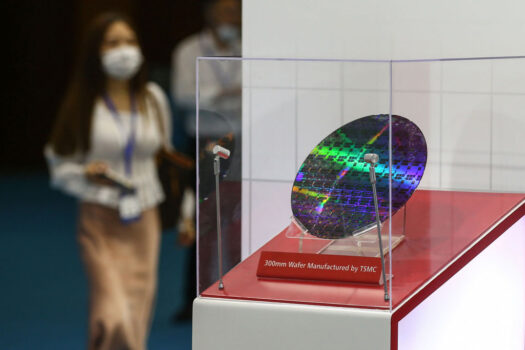
On the one hand, the United States welcomes Taiwan Semiconductor Manufacturing Company (TSMC) investing $100 billion in Arizona over the next three years to expand chip manufacturing capabilities; on the other hand, it is also working to strengthen domestic chip manufacturing and research. TSMC’s establishment of a factory in the United States to manufacture cutting-edge products such as 2 nm (nanometer) chips is actually a global relocation of the most advanced part of the semiconductor supply chain.
In the past several years, chip manufacturing in the semiconductor supply chain has increasingly concentrated in Taiwan. The CCP has taken advantage of the close economic exchanges between China and Taiwan to poach talent from TSMC, so it can gradually excel in chip technology. If the most advanced part of the semiconductor supply chain is kept in Asia, and the CCP continues to put increased pressure on neighboring countries, the CCP will likely seize the future global high-tech and economic lifeline and become an even more powerful hegemon.
The current global diversified layout of TSMC represents a new development in the industrial chain; that is, economic globalization must be included in the framework of the U.S.-China cold war, and the supply chain layout of democratic countries must have a security game plan. The key technologies and products related to national security must not be deployed to the de facto enemy—China.
Former U.S. Secretary of State Mike Pompeo said last year that the U.S.-China cold war is not version 2.0 of the U.S.-Soviet Cold War, because the former is more difficult to deal with. It could be challenging for the United States to win the cold war because the global economy has become so dependent on China.
The re-arrangement of the global industrial chain can only take place gradually. Everything is difficult at the beginning. We saw the first step of economic globalization version 2.0 when TSMC reset the layout of the semiconductor supply chain.
Japanese companies are also highly dependent on China’s supply chain, and the Japanese business community is preparing to enter economic globalization version 2.0, the new layout.
Japanese media Nikkei recently conducted a survey of 100 company executives. The results showed that 80 percent of companies with factories in Japan have begun to adjust their supply chains. Among them, Takahito Tokita, the president of Fujitsu, said, “Although it is impossible to reduce all the risks that occur in the world to zero, we need to take precautions to improve the ‘recovery ability’ if any unfavorable situation happens.” His words are representative of Japanese entrepreneurs, who reasoned it out after the risks associated with economic globalization version 1.0 surfaced one after another.
The aforementioned events show that economic globalization version 1.0, which centered around China as the “world’s factory,” is no longer the only choice for many countries and that resetting of the global supply chain is needed.
Cheng Xiaonong is a scholar of China’s politics and economy based in New Jersey. Cheng was a policy researcher and aide to former Chinese Communist Party leader Zhao Ziyang. He also served as chief editor of Modern China Studies.
Views expressed in this article are the opinions of the author and do not necessarily reflect the views of The Epoch Times.


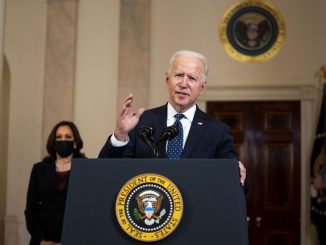


Be the first to comment